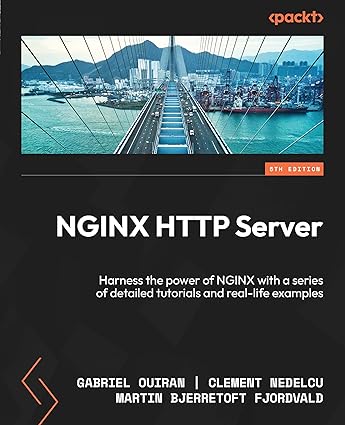Nginx, a high-performance web server and reverse proxy, has become a cornerstone of modern web infrastructure. This white paper provides a comprehensive overview of Nginx, covering its core functionalities, advanced configuration techniques, and best practices for optimizing performance and security. We delve into specific use cases, such as load balancing, caching, and content delivery networks (CDNs), to demonstrate how Nginx can enhance web application performance and scalability.
Nginx HTTP Server: A Comprehensive Guide
Abstract
Nginx, a high-performance web server and reverse proxy, has become a cornerstone of modern web infrastructure. This white paper provides a comprehensive overview of Nginx, covering its core functionalities, advanced configuration techniques, and best practices for optimizing performance and security. We delve into specific use cases, such as load balancing, caching, and content delivery networks (CDNs), to demonstrate how Nginx can enhance web application performance and scalability. Contact keencomputer.com
1. Introduction to Nginx
Nginx is a versatile web server known for its efficiency, reliability, and flexibility. It can handle a wide range of web traffic, from simple static content to complex dynamic applications. Key features of Nginx include:
- High Performance: Efficient handling of concurrent connections and low resource utilization.
- Flexibility: Configurable to serve various content types and handle different protocols.
- Reliability: Robust and fault-tolerant architecture.
- Security: Built-in security features to protect against common web attacks.
2. Core Functionalities of Nginx
2.1 Web Server
- Serving static content efficiently.
- Handling dynamic content through reverse proxying.
- Supporting various content types (HTML, CSS, JavaScript, images, etc.).
- Implementing custom error pages.
2.2 Reverse Proxy
- Load balancing traffic across multiple servers.
- Caching content to improve performance.
- Offloading SSL/TLS termination to Nginx.
- Implementing geo-IP based routing.
2.3 Load Balancing
- Round Robin: Distributing traffic evenly across servers.
- Least Connections: Directing traffic to the least loaded server.
- IP Hash: Hashing client IP addresses to ensure consistent server assignment.
- Least Response Time: Routing traffic to the server with the shortest response time.
3. Advanced Nginx Configuration
3.1 Virtual Hosts
- Creating multiple virtual servers on a single Nginx instance.
- Configuring domain names, SSL certificates, and custom error pages.
3.2 Caching
- Caching static content to reduce server load and improve response times.
- Configuring cache expiration times and invalidation strategies.
3.3 SSL/TLS Termination
- Securing communication between clients and servers.
- Implementing SSL/TLS certificates and configuring cipher suites.
3.4 Rate Limiting
- Protecting servers from excessive traffic and DDoS attacks.
- Limiting the number of requests per IP address or time period.
4. Nginx as a CDN
Nginx can be used as a powerful content delivery network (CDN) to improve website performance and reduce latency. By caching content at edge servers, Nginx can deliver content faster to users around the world.
5. Nginx Security Best Practices
- Keep Nginx Updated: Regularly apply security patches and updates.
- Secure Configuration: Avoid common configuration mistakes that can lead to vulnerabilities.
- Implement Strong Password Policies: Use strong passwords for Nginx accounts.
- Monitor Logs: Regularly review logs for suspicious activity.
- Use Web Application Firewalls (WAFs): Protect against web attacks.
6. Real-world Use Cases
- High-traffic websites: Handling large volumes of traffic and ensuring high performance.
- E-commerce platforms: Optimizing product catalogs and checkout processes.
- API gateways: Routing API requests to backend services.
- Microservices architectures: Load balancing traffic across microservices.
7. Conclusion
Nginx is a versatile and powerful tool for building high-performance and scalable web applications. By understanding its core functionalities, advanced configuration techniques, and security best practices, you can effectively leverage Nginx to improve your web infrastructure.
References:
- Official Nginx Documentation: https://nginx.org/en/docs/
- High Performance Browser Networking: By Ilya Grigorik
- The Nginx Cookbook: By O'Reilly Media
By following the guidance provided in this white paper, you can harness the full potential of Nginx to enhance your web applications and deliver exceptional user experiences.
